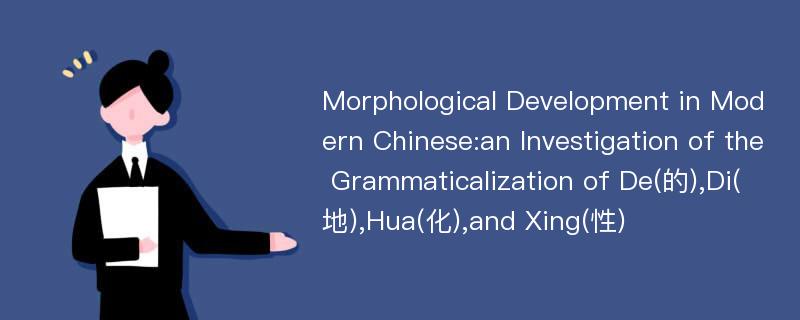
论文摘要
词缀构词法在现代汉语词形学的研究中正获得越来越多的关注(任学良1981,沈梦璎1986,马庆株1995,汤志祥2001)。另一方面由于汉字独立形态的特殊性,汉语词缀的定义鉴别具有很大的难度。以中文为母语的人仍然倾向于将独立的字等同于词,尽管现代汉语词汇已基本上被公认为是多音节的(De Francis1950,周有光1961,吕叔湘1963,陈平1999)。自由语素与黏着语素之间的区分以及词的划分,仍是汉语语言学着力探讨有待解决的问题。在现代英汉双语词典的词目译名中,有四个汉字其作为构词后缀的特征尤其鲜明。它们是:对应所有英语形容词后缀的“的”字,对应副词后缀“-ly”的“地”字,对应“-ize”,“-fy”等动词后缀的“化”字,以及对应"-ity","-ness"等名词后缀的“性”字。但是只有“化”和“性”在现代汉语词典中被普遍定义为后缀。而“的”和“地”在主流汉语语法书中都一般被作为在“的/地结构”中使用的助词。本论文研究的正是这四个汉字鉴于其在英汉词典词目译名中的使用的语法地位,致力于回答它们是否已经在现代汉语中语法化为后缀语素的问题。本论文采取“浮现语法”的研究视角,即将汉语词汇的形态发展看作一个正在进行中的过程。“的”字和“地”字作为语法功能词,其路径是实意词的借用,可以说已经完成了从实词到虚词的语法化(Heine等1991)。因而我们的研究重点是这两个字的“二度语法化”(Traugott2002),即是否从句法单位(虚词)进一步语法化为形态单位(后缀),并对其二度语法化的特定语境或结构(Bisang2010)做限定研究。本研究第一部分是对文献资料的梳理整合,包括两个来源:1)1822年至2003年之间具有代表性的英语/汉语词典,收集这四个汉字在这些词典中的定义(汉-英词典)和使用(英-汉词典),观察其历时的变化;2)1898年至2008年之间的汉语语法代表性著作,收集整理其中对汉语词缀的研究成果,尤其是关于“的”,“地”,“化”,“性”的讨论。第二部分是对这四个汉字实际使用情况的研究,以期寻找其语法化的证据,包括:1)一个现代汉语语料库(CCL)中的一手语言资料(报刊及文学),观察检验这四个字在相关语法语境中的使用是否符合词缀标准;2)在年轻的中文使用者中做一个心理语言学的调查问卷,检验人们对汉语后缀的认知程度(语法意识),以及对于“的”字和“地”字的词缀特性的认知度。语料库资料证实“化”和“性”已经在过去三十年里发展为派生后缀,尤其是在报刊写作中。它们将已有的词汇转化为新词的功能显而易见,并且正变得越来越多产。心理语言学问卷结果表明年轻的中文使用者也比较容易辨识“化”与“性”的词缀地位。另一方面,关于“的”和“地”的语料库资料显示它们在不同类型的形容词(单音节,双音节,重叠式)后面的使用情况有很大差别。“的”和“地”向后缀的转化主要基于对“的/地”结构的“重新分析”,而本论文的研究分析表明,在这些结构中这两个字具有形态意义上的功能,而非传统认为的句法意义上的功能。因此可以说,“的”和“地”已经分别二度语法化为形容词后缀和副词后缀。“地”字的二度语法化相对清晰,因为它可以与形容词结合生成新的副词单位;心理语言学问卷结果也表明中文使用者倾向于将“地”字认同为后缀。而“的”字作为形容词后缀的功能隐蔽性很强(多在已有形容词之后使用,虽然也有一定的构成新形容词的用法),而且现代汉语中“的”字功能多样,我们认为事实上存在很多同形不同义的“的”字语素,中文使用者对其后缀地位的认识相对模糊。但从浮现语法的视角来看,这恰恰说明“的”字在现代汉语中的后缀用法正处于不断发展的过程中。这四个汉字之间的比较强调了它们在汉语不断浮现的语法中所处的不同发展阶段,同时心理语言学问卷结果也揭示了罗马化之后汉语中的词缀形态具有更高的被认知度。
论文目录
摘要AbstractAcknowledgementsList of TablesList of FiguresList of AppendicesList of AbbreviationsChapter One:Introduction1.1 The"Inadequate Morhology" of Chinese1.2 Equivalence-building in English-Chinese Dictionaries1.3 Differences between English and Chinese Affixes and Difficulties in Identifying the Latter1.4 Monosyllabicity vs.Polysyllabicity and Wenyan vs.Baihua1.5 Character,Word,and Morpheme1.6 Chinese Word-order and the Contexts for Emergent Grammar1.7 Thesis OutlineChapter Two:The Suffix Use and Identification of de,di,hua and xing inEnglish-Chinese & Chinese-English Bilingual Dictionaries2.0 Introduction2.1 The Developing Use of the Four Characters in Equivalents in English-Chinese Dictionaries2.1.1 The six English-Chinese dictionaries2.1.2 De in forming explanatory phrases in the 19th century English-Chinese dictionaries2.1.3 Growing use of de in translational equivalents in the 20th century English-Chinese Dictionaries2.1.4 Developing use of di as the adverbial suffix2.1.5 Developing use of hua and xing as verbal and nominal suffixes2.2 The Developing Treatment of the Grammatical Meanings of the Four Characters in Chinese-English Dictionaries2.2.1 The eight Chinese-English dictionaries2.2.2 Treatment of de in the Chinese-English dictionaries:original meanings2.2.3 Treatment of de in the Chinese-English dictionaries:grammatical meanings2.2.4 Treatment of di in Chinese-English dictionaries2.2.5 Treatment of hua and xing in the Chinese-English dictionaries2.3 A brief review of the identification of affixes in contemporary monolingual Chinese dictionaries2.4 Concluding RemarksChapter Three:Definition and Identification of Affixes in Important ChineseGrammars in History3.0 Introduction3.1 The "Following-suit" Period:From Ma Shi Wen Tong to the late 1930s3.1.1 Three works on classical Chinese3.1.2 The first affix to be identified in modern Chinese:de(的)3.1.3 Qu Qiubai's Thoughts about Affixes3.2 The "Importing and Developing" Period:From the late 1930s to the late 1970s3.2.1 Additional elements and markers3.2.2 Word-tail and word-head3.2.3 Chao's affixes,versatile morphemes,and modern affixes3.2.4 The 1960s debate over de:one or more morphemes?3.3 The "Exploring Period":the Late 1970s till Present3.3.1 Affix,prefix,and suffix3.3.2 Quasi-affixes and the tendency of affixation3.3.3 The 1980s paradigm shift:de defined as one morpheme/particle3.4 An Examination of the Criteria for Identifying Affixes in Modern Chinese3.4.1 Emptiness of meaning3.4.2 Fixedness ofposition3.4.3 Ad hoc productivity3.4.4 Summary3.5 Concluding RemarksChapter Four:Methodologies4.0 Introduction:Central Hypothesis4.1 The Theoretical Approach of Emergent Grammar4.1.1 Emergent grammar and the concept ofgrammaticalization4.1.2 Context-based grammaticalization4.1.3 Secondary grammaticalization4.1.4 Reanalysis and degrees of analyzability in linguistic expressions4.2 The Corpus Investigation4.2.1 Chinese monolingual corpora4.2.2 CCL corpus and its two registers4.2.3 Categorization of adjective lexemes for corpus data collection4.2.4 Selection of adjectives for the corpus investigation4.2.5 Analysis of corpus data4.3 The Psycholinguistic Survey4.3.1 Survey participants4.3.2 Structure of the survey questionnaire4.3.3 Analysis of questionnaire resultsChapter Five:Analysis of Corpus Data:the Secondary Grammaticalization of "de/di"5.0 Introduction5.1 hua and xing5.1.1 Quantitative evidence on their usage as derivational suffixes5.1.2 Qualatitive analysis of their grammatical meanings as derivational suffixes5.1.3 Summary5.2 de after Disyllabic Adjectives5.2.1 Overview of corpus evidence of [DA-de]vs.[DA]in the attributive position5.2.2 Qualitative analysis of the secondary grammaticalization of de after DA5.2.3 Summary5.3 de after Monosyllabic Adjectives5.3.1 Overview of corpus evidence of[MA-de]vs.[MA]in the attributive position5.3.2 Qualitative analysis of the secondary grammaticalization of de after MA5.3.3 Summary5.4 de after Reduplicated Adjectives5.4.1 Quantitative evidence on the suffix nature of de after RAs5.4.2 Qualitative analysis of the suffix nature of de after RA5.4.3 Summary5.5 Synthesis of Findings for de after Adjectives5.6 di:the Adverbial Offshoot of de5.6.1 di as a new derivational suffix after DA lexemes5.6.2 Syllabic restriction on MA lexeme for the adverbial suffix di5.6.3 di after RAs5.6.4 Summary5.7 Concluding RemarksChapter Six:The Psycholinguistic Survey:Perceptions of Meaning and Morphology inOlder and Newer Chinese Suffixes6.0 Introduction6.1 Findings from Survey Questionnaire Part Ⅰ6.1.1 Participants' formal knowledge about Chinese affixes6.1.2 Perceptions about Chinese suffixes in characters6.1.3 Summary6.2 Findings from Survey Questionnaire PartⅡ6.2.1 Overview of Romanization test results6.2.2 Analysis of Romanization test results6.2.3 Summary6.3 Findings from Survey Questionnairc Part Ⅲ6.3.1 Equivalence building between de and English adjectival suffixes6.3.2 de:to use or nof to use6.4 Concluding RemarksChapter Seven:Conclusion7.1 Overall Findings7.1.1 Corpus verification of the grammaticalization of de,di,hua,and xing7.1.2 Cognitive verification of the grammaticalization of de,di,hua,and xing7.1.3 The "advancedness" of English-Chinese dictionaries in demonstrating linguistic development of the Chinese language7.1.4 The ongoing linguistic entrenchment vs.variable grammatical doctrines7.2 Theoretical Implications for Chinese Morphology7.2.1 Morphology in Chinese:a matter of perspective7.2.2 Visualization of Chinese derivational morphology in Pinyin7.3 Practical Implications for Bilingual English-Chinese/Chinese-English Dictionaries7.3.1 Presentation of adjectives with de in Englis-Chinese dictionaries7.3.2 Presentation of adjectives with de in Chinese-English dictionaries7.3.3 Labeling of parts of speech for Chinese words7.4 Limitations of This Inquiry and Directions for Future Research7.4.1 Limitations of Chinese corpora7.4.2 Potential linguistic contexts for further investigation of the grammaticalization of de7.4.3 Cognitive survey based on undergraduates only7.5 Concluding RemarksReferencesAppendices
相关论文文献
标签:双语词典论文; 语法化论文; 后缀论文; 汉语词汇形态论文; 浮现语法论文;
Morphological Development in Modern Chinese:an Investigation of the Grammaticalization of De(的),Di(地),Hua(化),and Xing(性)
下载Doc文档
